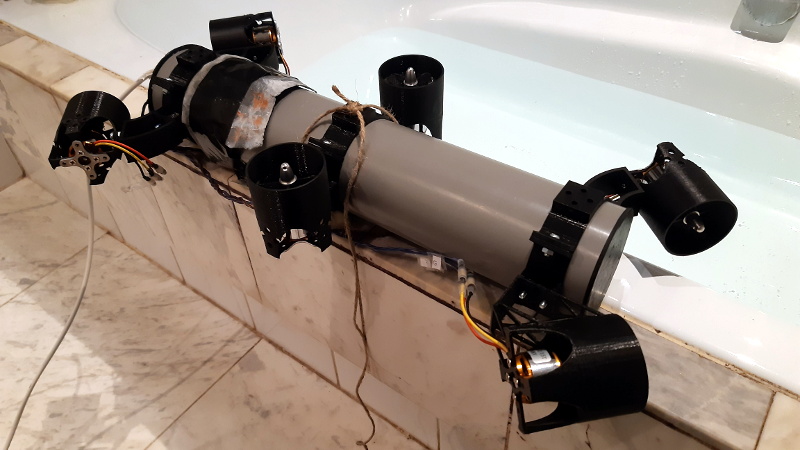Underwater exploration and research can be exceedingly dangerous, which is why remotely operated vehicles (ROVs) are so commonly used. Operators can remotely command these small submersibles to capture images or collect samples at depths which would otherwise be unreachable. Unfortunately, such technology comes at a considerable price.
Believing that the high cost of commercial ROVs is a hindrance to aquatic conservation efforts, [Noeël Moeskops] has been developing an open source modular ROV he calls Aruna. Constructed largely from off-the-shelf components and 3D-printed parts, the Aruna promises to be far more affordable than anything currently on the market. Hopefully cheap enough to allow local governments and even citizens to conduct their own underwater research and observations.
More than just the ROV itself, Aruna represents an entire system for developing modular underwater vehicles. Whether you decide to build the boilerplate ROV documented and tested by [Noeël], or implement individual components into your own design, the project is a valuable source of hardware and software information for anyone interested in DIY underwater robotics.





















A bunch of unanswered questions – the wiring is presumably temporary, since it looks like it would be easily snagged on things, but that’s just a cabling thing. I didn’t see much information on sealing – how does he get the wires from electronics inside the pipe to outside, without leaking? Is the center pipe thing pressurized or not? The motors look like bare motors – that might be ok, but are they “salt water compatible” – particularly things like bearings.
Most of the small scale ROVs I’ve see repurpose things like bilge pumps, which are *designed* to be operated immersed in water.
I’d also be curious to know about thermal management – putting a bunch of stuff in a closed box, particularly stuff like motor speed controllers, could raise temperature issues (on the other hand, you’ve got an enormous water cooled heat sink to transfer heat to).
overall, it looks more like an “electronics” project than a “underwater robotics” project.
I get a strong impression of “This is Rev 1” so a bit of Watch This Spot going on. pretty sure you can find stainless or ceramic wet/dry bearings suitable to underwater operation. they’ll cost more than your standard oiled/greased bearings though.
but also, hobby brushless motors are So Damn Cheap (relatively speaking) now that they might be considered a consumable element. I worry more about the sealing of wire junctions and splices than the motors themselves, tbqh
The brushless RC motors are definitely a consumable. They are so cheap that there’s no point bothering to waterproof them. Run them for a few dives and then throw them in the trash.
Why do they need waterproofing? They’re brushless, so there won’t be any shorting going on if they’re underwater.
Because they are going to rust/corrode with time. That’s why you eventually just throw them away.
You could try and clean them out after each use, maybe spray some WD-40 in them. But depends on what your time is worth.
It happened a few times that the motors showed signs of rust. That they did not turn a smooth or are stuck all together. Every time this happened it was fixed by powering the motors anyway and let it spin for a while. I only had to deconstruct a motor once, and I managed to save it. I now let the motors run after a dive to kinda spin the water out. But a real water-proof motor made with stainless steel would be a good idea for the future.
Then it gets to be “how long to swap” and what’s your “per dive” replacement cost. Amazon seems to have the motors for around $6-10 each. So that’s $50-60/refresh, which might not be too bad. At least the rapid replacement cycle means you don’t have to worry about corrosion. Compared to buying R/C fuel at $20/liter, it’s in the same sort of operating cost area.
And, as mentioned above, connectors. Stranded wire and liquids are an interesting combination what with capillary action.
considering motors as consumable seems a bit contrary for a project aimed at environmental monitoring and such
Hi Jim, sealing was indeed a big problem. I designed my own cap for the pipe (see https://github.com/aruna-rov/ROV-CAD-objects/blob/master/dop/dop_blueprint.svg). The wires are encased with kit in a 10 mm strain relief. With a rubber ring for closure. The pipe is not pressurized.
Have you pressure tested it yet (say, to 1 bar, ~10 meters depth)? This was always the problem I had. Getting a gland seal for a cable to a plate is easy (there’s off the shelf cheap parts for that – basically it’s a compressible gasket/o-ring), it was leakage along the wires (particularly the strands).
The furthers I have gone is ~2-3 meters. Is your project on Hackaday.io? Would love to read it.
Not online, 20 years ago experience and I’m not even sure I have pictures of it.
You might look at the online stuff on personal submersibles (psubs) and, alternately, DIY dive gear. Both of them have been solving these sorts of packaging problems for years and there’s probably totally off the shelf, inexpensive solutions. For instance, solid wires don’t have the capillary problem, so you can make a feed through bulkhead connector with solid wires cast in epoxy, and the connectors on either side. With the right materials and the miracle of o-rings, standing off a couple hundred PSI isn’t a problem, or, at least becomes a manageable leak.
For instance, certain kinds of spark plug make a fine high voltage, high pressure feedthrough. After all, they withstand the pressure in the cylinder when it fires. And they’re cheap. Not too great for lots of wires, though. But there’s a lot of inexpensive stuff that involves passing a wire through a pressure vessel wall. The McMaster-Carr catalog is your friend – even if you don’t buy from them, it will tell you what to search for, i.e. the *name* of the thing you’re looking for.
How you Design bracket on brushless, can you teach me?
Maybe a pressure sensor to relay depth would be a nice way to maintain depth without being jerky. Would make for a smoother ride and better video when used.
Poor depth control close to the surface is pretty common on things with any buoyancy, especially if there’s flexible volumes. The pressure gradient, as a percentage of the pressure, varies very fast close to the surface (i.e. a 2:1 pressure gradient going from 30 cm to 60cm, but a much smaller gradient going from 10.0 to 10.3). Scuba divers will be quite familiar with this problem.
There are some clever schemes for controlling buoyancy with compressors and pumps, but they’re all tricky close to the surface.
Hi Ken, Good idea I already bought a pressure sensor but have not implemented it yet.
In the old RC model submarine days 20 odd years ago, we had an electronic “depth keeper” and also an “angle keeper”, which would keep the model from porpoising. May be worth search for those items on the web, may give you some ides of how they implemented it. May not need to re-invent it!
Let me preface my remarks with the fact that I’ve worked in the commercial ROV industry for nearly 30 years.
1) This thing is going to be very difficult to keep from rolling. Inexpensive electric motors subject to environmental conditions are not going to turn at the same speed for a given voltage, ergo roll.
2) Conxall makes a line of inexpensive waterproof connectors. Use them….
3) You ARE going to knock one or more thrusters off with them exposed like they are.
4) Agree with many others. Use bilge pump motors for your thrusters. Waterproof for the depths this was designed for. My son and I built an ROV years ago using them and they worked just fine.
5) A box form factor would eliminate issues 1 and 3. We used two PVC pipes mounted on a base made from an UHMW cutting board. Cheap and easy.
6) You have an umbilical. Use it for power and eliminate the batteries. SJ waterproof cables are available with multiple wires.
7) Video. Without video, not certain what use this thing would be.
8) A joystick interface would make piloting much less problematic than using a laptop keyboard.
Ping me if you need help. BTDT….
Another comment:
If you get your ballast right, you use the thrusters for depth control. Variable bouyancy is a non starter…